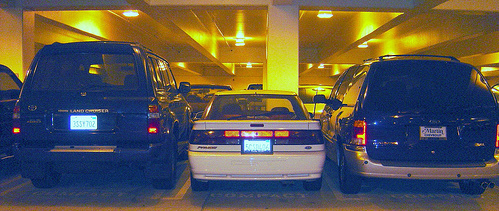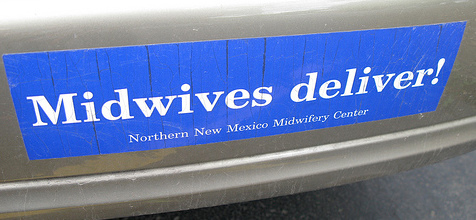What SUVs Can Teach Us About Maternity Care
By: Amy M. Romano, RN,CNM | 0 Comments
Twice last week, analogies between sport utility vehicles (SUVs) and the organization of our maternity care system came up in blog comment discussions. In a spirited discussion between Katharine Hikel and AcademicObgyn.com's Nicholas Fogelson on Hikel's post, Disputed Territory, she proposed, 'maybe it's time to change from the SUV model to the compact hybrid... The ACOG hospital model is neither sustainable nor affordable.' In a thoughtful post about military terminology and philosophy in healthcare at e-Patients.net, again conversation turned to the American enhusiasm for SUVs.
Henci Goer and I decided it would be fun to share a sneak peak excerpt of our book, Obstetric Myths versus Research Realities, 2nd edition, due out late next year. With apologies to those who drive SUVs, here it is...;
What SUVs Can Teach Us about Maternity Care
Excerpt from Goer, H. & Romano, A. (In Press) Obstetric Myths versus Research Realities, 2nd Edition, The University of Michigan Press: Ann Arbor, MI.
A recent advertising campaign for a large sport utility vehicle (SUV) offers an excellent analogy to conventional thinking in maternity care. Parallel to the 'just in case' approach of obstetric management, the ads acknowledge that the average SUV driver will hardly ever need the heft and power of an SUV, but the 'one percent' chance of being caught in a blizzard or hurricane means the driver would be wise to own a vehicle that can safely navigate treacherous conditions. The SUV, the ads declare, is 'built for the one percent.' Let us see how the flaws in this argument translate to maternity care.

- The technology that makes an SUV superior in severe adverse driving conditions provides no benefit to the driver 99% of the time because severe adverse driving conditions are rare. Likewise, the technology that can improve outcomes in very problematic pregnancies provides no benefit to most women and babies most of the time because these conditions are rare.
- Most SUV drivers live in temperate climates, where the likelihood of a blizzard or similar natural disaster on any given day is extremely low. Likewise, most pregnant women are healthy and at low risk of experiencing a 'natural disaster' during childbirth.
- The driving conditions in which an SUV offers an advantage are usually predictable. Blizzards and hurricanes, for example, rarely take a driver completely by surprise. Likewise, we can often predict which women will develop complications in pregnancy or birth. Most pregnancy and labor complications develop slowly, giving plenty of time to avert them or access the resources needed to safely manage them.
- Individuals and society as a whole expend resources to build, fuel, and maintain SUVs and to accommodate them on our roadways despite the fact that most people could drive smaller cars most of the time and be equally well off - or better off.Likewise, technology-intensive obstetric management is extremely costly and requires specialized staff resources and physical infrastructure to support it, despite the fact that a lower-technology approach with access to technology when it is indicated provides equivalent or better outcomes.
- Although the SUV's bigger size and greater weight offer some protection when collisions occur, these same characteristics make them more prone to accidents.The weight of the vehicle makes it more difficult to brake to avoid collisions and the higher center of gravity is responsible for more rollovers. The net effect is that SUVs may actually be more likely than smaller cars to be involved in serious or fatal accidents to drivers or passengers. Likewise, obstetric interventions can be beneficial in some circumstances, but their use frequently results in iatrogenic harm. The net effect is that women and infants often fare worse than if they had not been exposed to the intervention in the first place.
- Some people choose an SUV because they genuinely need one for the road conditions under which they do most of their driving. In these cases, an SUV makes sense. Likewise, women who have medical problems or are likely to develop pregnancy or labor complications will benefit from intensified use of obstetric technology. These women are likely to seek out specialist care.
- Although we can measure the degree to which weather or traffic conditions are poor and accidents more likely, this information cannot tell us which cars are destined to get into accidents or whether any individual accident will be minor or major. Similarly, screening tests (e.g., fetal surveillance, electronic fetal monitoring) and prenatal risk or candidacy for VBAC scoring systems have poor predictive value and lead obstetricians to over treat. They also fail to distinguish problems where intervention can help from problems where it cannot.
- Most accidents are fender-benders that cause no more than minor harm no matter what kind of vehicle is involved. Likewise, most complications in pregnancy and birth are minor and will not result in any serious or long-term harm to mother or baby no matter what kind of care they receive.
- Some accidents will cause major injury or death no matter what kind of vehicle is being driven. Likewise, some babies and even some mothers will suffer severe morbidity or die no matter what kind of care they receive. Even in the best-equipped hospitals with superbly qualified staff, in some cases, nothing can be done to prevent the worst from happening.

Published: December 05, 2009
Tags
InterventionsACOGProfessional ResourcesHospitalsMaternity Care Systems